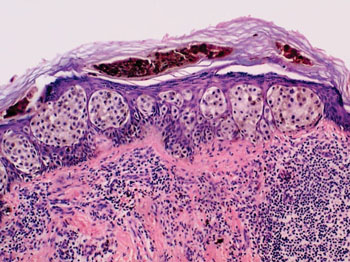Noncoding RNA Gene Linked to Malignant Melanoma
By LabMedica International staff writers
Posted on 05 Apr 2016
While a large share of the human genome has long been considered “junk DNA” because it does not contribute to protein coding, recent insights indicate that it does produce many noncoding ribonucleic acids (RNAs) that play important roles in essential biological processes and diseases. Posted on 05 Apr 2016
A remarkable link has been found between malignant melanoma and a noncoding RNA gene called SAMMSON. The SAMMSON gene is expressed in human malignant melanoma and, strikingly, the growth of aggressive skin cancer is highly dependent on this gene. The conclusions could pave the way for improved diagnostic tools and skin cancer treatment.

Image: Histopathology of a skin section from a patient with superficial spreading malignant melanoma (Photo courtesy of Profs. Leszek Wozniak and Krzysztof W. Zielinski).
A European group of scientists led by those at the VIB, the Flanders Institute for Biotechnology (Leuven, Belgium) have shown that show that the recently annotated long noncoding RNA (lncRNA) gene SAMMSON is consistently co-gained with Microphthalmia-Associated Transcription Factor (MITF) gene. Their results indicate that silencing of the lineage addiction oncogene SAMMSON disrupts vital mitochondrial functions in a cancer-cell-specific manner; this silencing is therefore expected to deliver highly effective and tissue-restricted anti-melanoma therapeutic responses.
The scientists discovered a remarkable dependency of melanoma cells on SAMMSON expression. When reducing the presence of SAMMSON in melanoma cultures, cancer cells rapidly and massively die off, irrespective of the type of melanoma. This led to the key conclusion of a “SAMMSON addiction.” As the SAMSSON gene is not expressed in benign melanoma, its occurrence could be a key factor in developing new diagnostic tools that may dramatically improve melanoma prognosis.
Pieter Mestdagh, PhD, from Ghent University (Belgium) and a senior coauthor of the study, said, “Our study showed that the long noncoding RNA gene SAMMSON is specifically expressed in human melanomas and duplicated or amplified in about 10% of the cases. In addition, SAMMSON was nowhere to be found in melanocytes, the normal melanin-producing cells, nor in any other normal adult tissue. This unique expression profile of SAMMSON led us to hypothesize that this gene might play an important role in the etiology of melanoma.” The study was published on March 23, 2016, in the journal Nature.
Related Links:
VIB the Flanders Institute for Biotechnology
Ghent University














